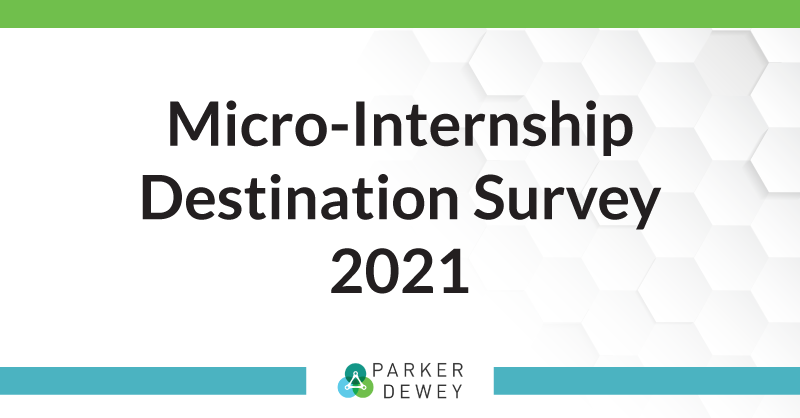.png)
Where Virtual Recruiting Fits In
Interesting research results were published last week by the Scott Resource Group comparing virtual and onsite recruiting over the past couple of years. Obviously, it's been a dynamic time, but a key takeaway that stood out to us is that adding the word "virtual" in front of all of the traditional hiring processes (virtual career fairs, virtual interviews, etc.) didn't satisfy the students' expectations.
We've always agreed that virtual cannot (and should not) replace on-site recruiting, and when done incorrectly can hurt conversion, diversity, and retention outcomes as highlighted in the report.
But we also know that virtual recruiting tools can serve as a powerful complement to in-person efforts, helping expand access for students, enhance employer branding, lower costs, and improve hiring outcomes.
As we’ve seen during the past six years, Micro-Internships are a great example of this. Even before the pandemic, companies were finding a 40-80% lower cost per hire, >5x increase in student engagement, and dramatically increased diversity.
Not only do Micro-Internships work help companies improve their campus recruiting pipelines and provide a more accessible option for students of all backgrounds, but they also take work off a busy team's plate. Plus, based on the feedback we heard last summer, paid experiences are what students want.
Does this replace the personal relationships that you can create through in-person recruiting? Of course not—but it can be a powerful and more accessible way to establish a relationship.
Kristin Schrader
Director of Partnerships
Articles of the Week
Micro-Internship Destination Survey 2020 - Parker Dewey
Why You Should Invest in Unconventional Talent - Harvard Business Review
Gen Z Expects Employers to Treat Them Differently. Here's How to Bridge the Generational Gap. -Entrepreneur
The Talent Revolution Is Here: What’s At Stake And How To Respond - Forbes
Micro-Internship Destination Survey 2020 - Parker Dewey
"Just as students and recent graduates were challenged to find new ways to network and gain experience, the world of internships and recruiting was also met with a need to adapt. And at Parker Dewey, we’ve seen firsthand just how impactful remote Micro-Internships have become over this last year—even as recent graduates entered into the worst job market in over a decade. “
We sent our 2020 Destination Survey to Career Launchers who completed a Micro-Internship in the 2019-2020 academic year. The goal: to better understand how Micro-Internships prepare students and recent graduates for future opportunities, support skill-building, and build connections across different industries. Check out this blog post for our survey findings and input from Career Launchers.
Related reading: Student Success: How Kenzie's Micro-Internship Shaped Her Career Plans
Why You Should Invest in Unconventional Talent - Harvard Business Review
“Many, if not most, skills can be taught on the job; what matters is the desire and core capabilities to succeed. Jobs are changing so rapidly that adaptable learners are in high demand.”
There’s no shortage of data to illustrate that a more diverse company means a better performance, a stronger ability to innovate, and a clear competitive advantage. In this article, two senior leaders from payroll platform Gusto weigh in on why and how companies should seek talent from outside of their traditional candidate pools to build a diverse, inclusive organization. Their recommendations include strategies that are core to Micro-Internships, like: “Focus on potential rather than pedigree” and “help unconventional candidates envision themselves at your company.”
Related reading: How Micro Internships Can Bring Diversity, New Perspectives, and Talent to Employers
Gen Z Expects Employers to Treat Them Differently. Here's How to Bridge the Generational Gap. -Entrepreneur
“Whether your company is in its startup phase or a later-growth stage, the odds of achieving your goals in [a] diverse professional landscape improve when you leverage the generation gaps among your employees and partners. Many companies have experience managing the challenges of a generation gap, but few leaders actually utilize generational differences for the employees' and company's benefit.”
Today’s workforce spans four different generations. Beyond addressing the challenges of a generation gap within a company, organizations can actually use these differences to boost collaboration and productivity. This article explains how.
Related reading: Three Recruiting Shifts You Should Make to Be Ahead of the Curve
The Talent Revolution Is Here: What’s At Stake And How To Respond - Forbes
“There are seismic shifts happening today related to what people are demanding of their employers, how they plan to work and even where they will put down new roots. Talent is one of the most important challenges currently facing us. And if you’re not reconsidering, refreshing and reinventing your talent strategy, it is likely you will be left behind.”
As companies enter into a “war for talent,” organizations will need to reevaluate what it takes to find and keep skilled, motivated, and committed employees. This article takes a look at the shifting landscape of worker supply and demand, plus starting strategies for attracting talent. (Micro-Internships are a great way to get early access to ambitious college students and recent grads!)
Related reading: Is Your Company Ready for the Future of Work?
For more stories and insights on HR, recruiting, and diversity, click here to subscribe to our weekly newsletter Hire Learnings.



.png)
